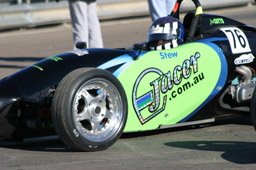 I have noticed recently a lot of drivers wasting precious lap time and making their car unstable through careless gear changing.
I have noticed recently a lot of drivers wasting precious lap time and making their car unstable through careless gear changing.
Some might wonder how you could possibly make your car handle worse with the gears? Let me tell you, it happens!
There is also much to be gained from an efficient up change, and understanding when is the correct moment to change gear.
Let me start with the 4th to 3rd gear change, the “down change”.
We have all heard it, I cringe when I do, that screaming engine noise at the end of the straight where a driver has thrown it to 3rd before slowing down… ouch. This causes several nasties for your car. For starters, the engine doing 5000 rpm in 4th gear suddenly has to attempt to do over 6000 rpm… not good for the crank, the case, any of it, lets not even start on the 40+year old gears in the transmission! It also becomes a sudden extra rear brake that attempts to make the car’s rear end overtake the front. The drivers who do this often will complain about the car being unstable on turn in, and the engine seems to “go off” quicker… really?!!
Give your car a break, and your engine builder, while going faster and being in more control. Try braking first, before the simultaneous pedals and gear lever slam. Wash off some speed and attempt to perform the gear change half way between your initial braking and the moment you turn into the corner. What you should notice is the rear of your car suddenly becomes more stable. The turn in then gives more confidence and you will be able to start accelerating again much sooner. It is also likely you can add some more rear brake to your bias which will help you be able to stand on the anchors harder without locking front brakes.
Here is a tip. On your next practice day, attempt to go as fast as you can whilst staying in 4th gear. This will give you an appreciation and confidence in the initial braking capability of your car. Do the next session attempting the change down after initial braking, not before or during. I reckon you will notice just how much more stable the rear of your car is.
Now for the “up change”. Most people have had their car dyno tuned, yet I am willing to bet on the fact that even though you have a pretty graph in front of you, you have not bothered to read and understand how and where you should be changing up gears to make maximum effect of your available HP.
My advice is to see where your HP and torque start to climb and the point where they fall off. If you don’t know how to map out your gear charts against RPM, then spend your Friday test session trying different RPMs in 3rd gear and see where the 4th gear RPM starts. Keep trying different RPMs until you get to or as close to having the start point of your HP curve as your 4th gear RPM, and the drop off point as your 3rd gear up change marker. Lap time reduction can be gained from ensuring the point at which you change up to 4th gear from 3rd is the best compromise for both rev ranges in terms of torque and HP.
There is no point revving the car to 6krpm if your power runs out at 5k. Most 1600 cars reach max torque and HP somewhere in the 4-5000 rpm region, I rarely rev a car past 5200, there’s no point.
I will often be coming onto the straight at Eastern Creek doing what seems to be idling in 4th gear, and yet I am making car lengths up on the car in front revving the manhood out of their 3rd gear… it makes me laugh how some people think noise is power. Noise is wasted energy.
Remember! Brake first, then change down gears on your down change. Use your tacho, not your ears for the “up change”.

Follow Us!